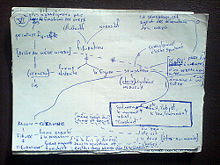Effective Note Taking
From Learnmore
Making the grade: How to do effective note taking?
There are many factors that contribute to the successful study of law, and effective note taking is one such factor. Effective note taking is important, as many students struggle to find an effective study method, resulting in a feeling of being overwhelmed by pages and pages of not-very-helpful notes. This need not be the case! Hopefully this article will help you to organise yourself and enjoy the study of law.
So, how do you take effective notes? This article focuses on the technique I developed while studying in the Graduate Entry LLB programme. However, a word of caution is that every law student will develop a personal style that enable them to best understand, retain and recall material. Therefore, this is best used as a guideline to develop your own methodology.
I developed a two-step note taking process:
- Step one is the structuring of a detailed set of notes from relevant textbooks, articles, case summaries and analysis;
- Step two involves structuring a set of revision notes. The alternative would be to have completed all of the required reading from the various sources and then compose one set of revision notes. This largely depends on what works best for each individual.
Note taking: summarising information
Use the subject handout as a guideline to structure the notes according to the topic headings. Summarise the key points in recommended readings for each topic using, for example, bullet points, underline key words, or bold case names.
Example 1 – general summary of material:
Test for the exercise of the principle of subsidiarity: (a) that no Community action should be taken unless the action cannot be sufficiently achieved by the Member States (b) that because of the proposed scale or effects of the measure, the Community could better achieve the end result desired.
Principle of proportionality: third Para of Art 5 “any action by the Community shall not go beyond what is necessary to achieve the objective of this Treaty.”
Read the required and recommended case law, articles, chapters from textbooks, and additional material. For example, read the Financial Times which is particularly useful for Banking Law and International Economic Law.
Example 2 - case law summary:
Costa v ENEL: 'Facts: involved an alleged conflict b/w a number or treaty provisions and an Italian statute nationalising the electricity company of which the D, Signor Costa, was a shareholder, but here the Italian law was later in time that the treaty provision. Argued: the Italian Act nationalising the electricity company was later in time than the Italian Ratification Act (the Act incorporating EC law) – question of priorities – and therefore took priority.
Courts: the principle of supremacy was affirmed citing Van Gend: the Member States had ‘limited their sovereign rights’. Art 249 = indicated that there had been a transfer of powers to the Community institutions; Art 10 = underlined Member States commitment to observe Community law.
Example 3 – article summary: Name, year of publication and journal of publication: summary of key points In addition to reading the recommended material, it is important that the reading is completed before or soon after the relevant lecture. This enables you to develop a clear understanding of the topic and issues, thus contributing to effective note taking. Students in the Graduate Entry LLB programme will find that keeping up with each week’s lecture, will ensure that there will be more time for revision during the revision period.
Note taking: summarising revision notes
At the stage of writing your revision notes you must have a strong understanding of the topic, that is the important issue. Consider, the relevant case law, the key cases, the applicable statutes, and also consider current debates surrounding the topic which can be gathered by reading relevant articles. When writing the answer plansstructure the answer plan like a model answer and in a way that is easy to recall any key case law, statute and articles.
Example 4 - answer plan for a question in EU law:
Essay question on supremacy
a) Introduction: whether it’s an essay or problem question, having a good introduction is important. The introduction must include the definition, what are the important cases and legislation (why they are important), the structure of the answer and the thesis statement (e.g. important legislation in a supremacy question - Art 249, 10 and 5 EC).
b) First sub-heading, (Emergence and evolution of the principle of supremacy: Van Gend en Loos – first sets out the principle of supremacy) • Affirmed in Costa v ENEL: give a very brief description of the case and focus on the significance of the decision. • International Handelsgesselshaft GmbH • Simmenthal SpA
c) Second sub-heading, (Principle of supremacy stops short? Significance of the Francovich/ Factortame decision): • Joseph Weiler (1981, YEL): what is the author arguing, what are the key issues relevant to the topic • Political significance of supranationalism and is it the case today? Compared to other multilateral organisations EU is unique and this is character it gains from the ECJ jurisprudence. What does the future hold?
d) Conclusion
In an exam setting, based on the extent of exam writing practice the student has had, it’s important to limit the answer to two or three sub-headings. A good introduction is very important and in the conclusion it is important not to introduce any new material, but provide a synopsis of the answer.
Using an effective study method should enable you to focus your study time to effectively gather information, gain a better understanding of the subject and better prepare for exams. Good luck!
STOP PRESS! Anjalie has provided us with some more detailed examples of notes for planning essays - check them out.
Many thanks to Anjalie Athukorale for this really instructive piece. Anjalie completed her GELLB at City in June 2011 and has now relocated to Oslo to pursue her legal career.

